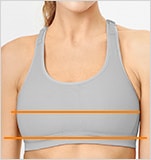How to measure
If possible, get a friend to help.
How to Find Your Bra Size
here are two elements to your bra size: the band size (i.e. 32, 34, 36, 38, 40) and the cup size (i.e. A, B, C, D, DD). You will need a measuring tape to determine your bra size.
You should take your measurements while you are wearing a non-padded underwire bra or a tight-fitting seamless tee.
Because standard band sizes are even numbers only, you may need to go up or down a size (depending on how you like your bra to fit) if you have an odd-number band size.
Band Size
Wrap the measuring tape tightly around your rib cage (just below your bust), then add 5 inches to the measurement. For example: a ribcage measurement of 27” + 5”= 32” band size.
Double Check
You can double check your band size by measuring loosely around your back, even with your bra line, bringing the tape to the front just above your bra line.
Cup Size
Measure loosely around the fullest part of your bust, then subtract your band size from this measurement. A difference of 1”= A, 2”= B, 3”= C, 4”= D, 5”= DD. For example: a cup measurement of 34” - 32” band size = 2” or a B cup.
Now that you have your measurements, knowing how the bra should be positioned on your body will also help you find your perfect bra.
Find Your Right Fit
How your bra is positioned on your body is as important as taking accurate measurements. Here are a few key points to keep in mind when you're trying on bras to ensure that you get the right fit:
The Band
Should be fitted, but not cutting into your skin (you should be able to fit two fingers comfortably under the band). It should sit lower on the back than in the front. The back of the bra should not ride up above the bra line. If it does, adjust the straps. If the bra still rides up, try a smaller band size.
The Underwire
Should completely surround the breast tissue to provide support.
Sports Bras
